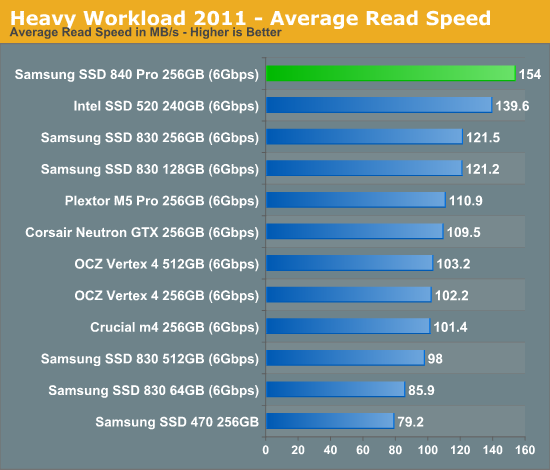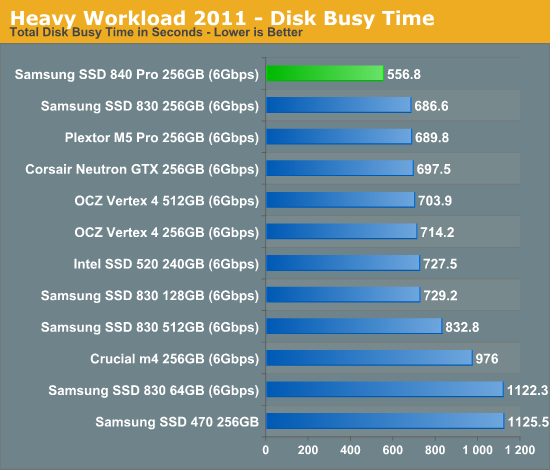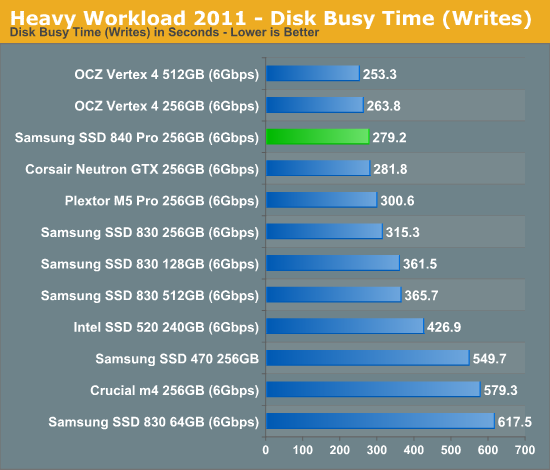Samsung SSD 840 Pro (256GB) Review
by Anand Lal Shimpi on September 24, 2012 7:00 AM EST- Posted in
- Storage
- SSDs
- Samsung
- Samsung SSD 840
AnandTech Storage Bench 2011
Two years ago we introduced our AnandTech Storage Bench, a suite of benchmarks that took traces of real OS/application usage and played them back in a repeatable manner. I assembled the traces myself out of frustration with the majority of what we have today in terms of SSD benchmarks.
Although the AnandTech Storage Bench tests did a good job of characterizing SSD performance, they weren't stressful enough. All of the tests performed less than 10GB of reads/writes and typically involved only 4GB of writes specifically. That's not even enough exceed the spare area on most SSDs. Most canned SSD benchmarks don't even come close to writing a single gigabyte of data, but that doesn't mean that simply writing 4GB is acceptable.
Originally I kept the benchmarks short enough that they wouldn't be a burden to run (~30 minutes) but long enough that they were representative of what a power user might do with their system.
Not too long ago I tweeted that I had created what I referred to as the Mother of All SSD Benchmarks (MOASB). Rather than only writing 4GB of data to the drive, this benchmark writes 106.32GB. It's the load you'd put on a drive after nearly two weeks of constant usage. And it takes a *long* time to run.
1) The MOASB, officially called AnandTech Storage Bench 2011 - Heavy Workload, mainly focuses on the times when your I/O activity is the highest. There is a lot of downloading and application installing that happens during the course of this test. My thinking was that it's during application installs, file copies, downloading and multitasking with all of this that you can really notice performance differences between drives.
2) I tried to cover as many bases as possible with the software I incorporated into this test. There's a lot of photo editing in Photoshop, HTML editing in Dreamweaver, web browsing, game playing/level loading (Starcraft II & WoW are both a part of the test) as well as general use stuff (application installing, virus scanning). I included a large amount of email downloading, document creation and editing as well. To top it all off I even use Visual Studio 2008 to build Chromium during the test.
The test has 2,168,893 read operations and 1,783,447 write operations. The IO breakdown is as follows:
| AnandTech Storage Bench 2011 - Heavy Workload IO Breakdown | ||||
| IO Size | % of Total | |||
| 4KB | 28% | |||
| 16KB | 10% | |||
| 32KB | 10% | |||
| 64KB | 4% | |||
Only 42% of all operations are sequential, the rest range from pseudo to fully random (with most falling in the pseudo-random category). Average queue depth is 4.625 IOs, with 59% of operations taking place in an IO queue of 1.
Many of you have asked for a better way to really characterize performance. Simply looking at IOPS doesn't really say much. As a result I'm going to be presenting Storage Bench 2011 data in a slightly different way. We'll have performance represented as Average MB/s, with higher numbers being better. At the same time I'll be reporting how long the SSD was busy while running this test. These disk busy graphs will show you exactly how much time was shaved off by using a faster drive vs. a slower one during the course of this test. Finally, I will also break out performance into reads, writes and combined. The reason I do this is to help balance out the fact that this test is unusually write intensive, which can often hide the benefits of a drive with good read performance.
There's also a new light workload for 2011. This is a far more reasonable, typical every day use case benchmark. Lots of web browsing, photo editing (but with a greater focus on photo consumption), video playback as well as some application installs and gaming. This test isn't nearly as write intensive as the MOASB but it's still multiple times more write intensive than what we were running in 2010.
As always I don't believe that these two benchmarks alone are enough to characterize the performance of a drive, but hopefully along with the rest of our tests they will help provide a better idea.
The testbed for Storage Bench 2011 has changed as well. We're now using a Sandy Bridge platform with full 6Gbps support for these tests.
AnandTech Storage Bench 2011 - Heavy Workload
We'll start out by looking at average data rate throughout our new heavy workload test:

A strong showing in all of our low level IO tests, with no drawbacks, results in 24% better performance than the 830 in our heavy workload. There's simply no faster drive than the 840 Pro.


The next three charts just represent the same data, but in a different manner. Instead of looking at average data rate, we're looking at how long the disk was busy for during this entire test. Note that disk busy time excludes any and all idles, this is just how long the SSD was busy doing something:













96 Comments
View All Comments
nextel2010 - Tuesday, September 25, 2012 - link
I couldn't agree more. I have two Samsung 830's, and they have been bulletproof. I used them to replace two Intel 520's, one of which was BSODing several times a day, and the other intermittently, both on previously stable systems. The SF-2281 controllers on those still need work, in spite of Intel's best efforts to date. The 830's have reliable, proven controllers. In practice, they are as wicked fast as the 520's. I never regretted switching over from Intel. While the 840's are likely to take the performance crown, to me, the 830 is fast enough, and new controllers make me nervous. Give me a year of proven stability, and I'll consider switching (of course, the 850 will be out by then...).FunBunny2 - Tuesday, September 25, 2012 - link
The only problem with waiting a year: with Moore still in control (mostly, really, integration) controllers go out of style in a year. I wonder how long any stable manufacturers (let alone the likes of OCZ) will still have a controller 3 or 5 years out?IOW, just as we don't really need the "improved" iPhoneX every so often, the same is true in the SSD space. It's planned obsolescence.
Old_Fogie_Late_Bloomer - Tuesday, September 25, 2012 - link
After moving my Steam folder from my SATA II Intel 320 160Gb to my SATA III Samsung 830 64GB and seeing basically no difference in load times, I have to say that I'll probably keep my eyes peeled for deals on the 830, rather than jumping on the 840. If I could get a 512GB for my laptop for under $400, I'd jump on it and not worry about the difference in performance.HisDivineOrder - Wednesday, September 26, 2012 - link
Agree on the massive discount, but... so far I haven't seen a "massive discount." The 256gig drive I've been eyeing has been hovering around the $200 price point for a long time now. That's not massive to me. Newegg priced it once for $180 and that was pretty decent for a "massive" discount, but they only did that twice and haven't done it in a long while (ie., since I had the cash to invest).This is especially relevant when I expect the 840 Pro to drop around that point ($200-ish) once supply matches demand within a couple of months. I'm not interested in beta testing TLC for Samsung either.
And I'd probably pay an extra $20 ($220) to have the superior performance/perf per watt of the 840 when push comes to shove.
dananski - Monday, September 24, 2012 - link
Very impressive indeed. Quite a decent improvement on their main performance competitor - their own 830. Don't think it'll be necessary to upgrade from said 830 in my desktop, since that is lovely and fast already, though with the far lower power consumption this could be an ideal laptop upgrade for pretty much anyone :)Eeqmcsq - Monday, September 24, 2012 - link
Mmm... bumping up against that SATA 6 Gbps wall. I can't wait for SATA Express to bust through this wall. I know the faster interface won't make much difference for typical real-world use cases, but SSD performance has increased so quickly over the past few years, I don't want to see its progress slowed by an interface bottleneck.iwod - Monday, September 24, 2012 - link
Yes we really need those quick. And hopefully straight to PCI-E 3.0 as well so it would provide us a true Bi-Directional 2GB/sI think we will hit diminishing of returns once we hit that high numbers with the current software.
nathanddrews - Monday, September 24, 2012 - link
While a 2GB/sec sequential access would be awesome - no disagreement there - it won't feel like much of an upgrade without a significant gain in random IO. A drive that hits the 6Gbps peak in random 4K access would impress me more.Grok42 - Monday, September 24, 2012 - link
Whatever the next interconnect is, I hope they build it for the next 10 years. I'm tired of all these incremental improvements requiring different cables. Maybe I've just been building computers too long?Denithor - Tuesday, September 25, 2012 - link
SATA Express isn't going to require a different cable. Go read the article for more details.